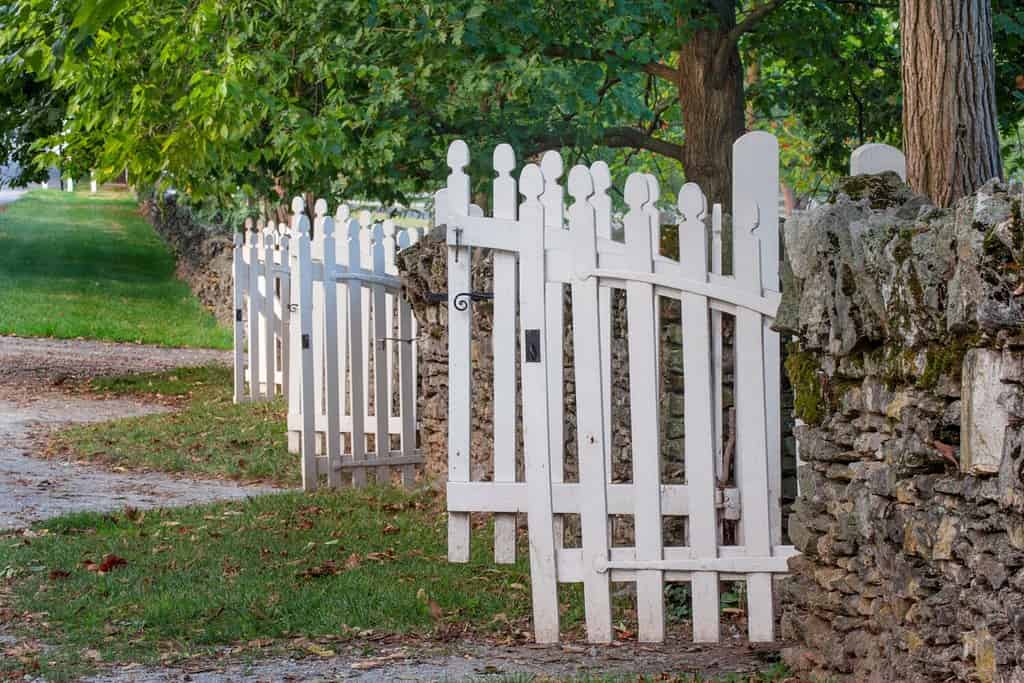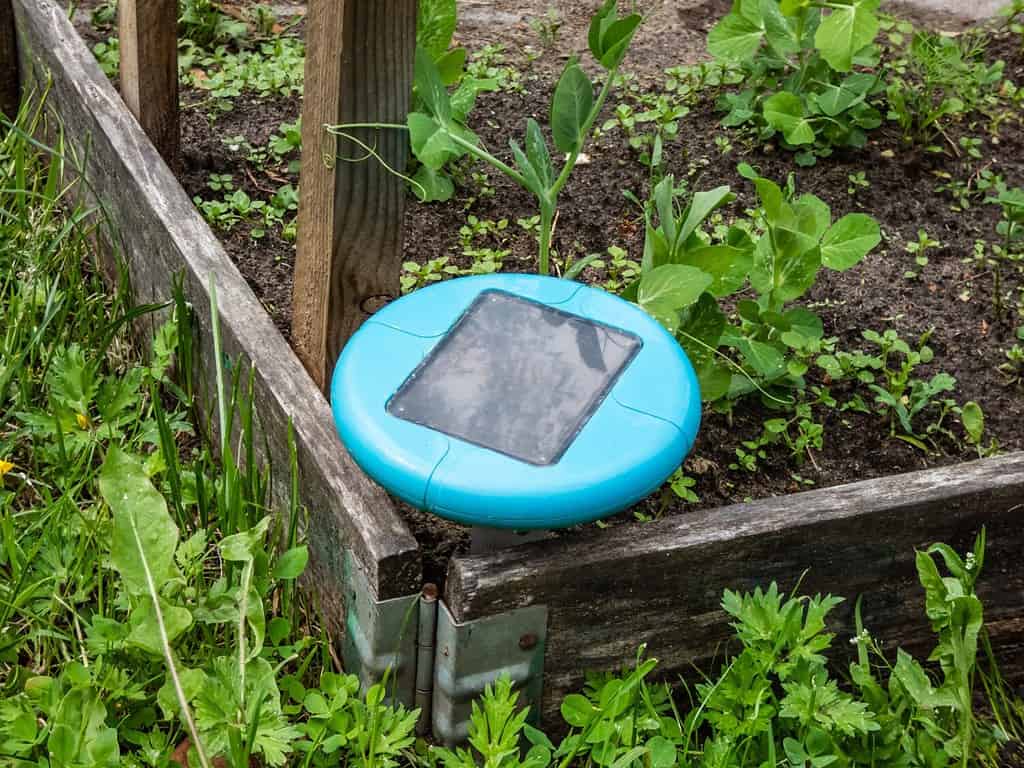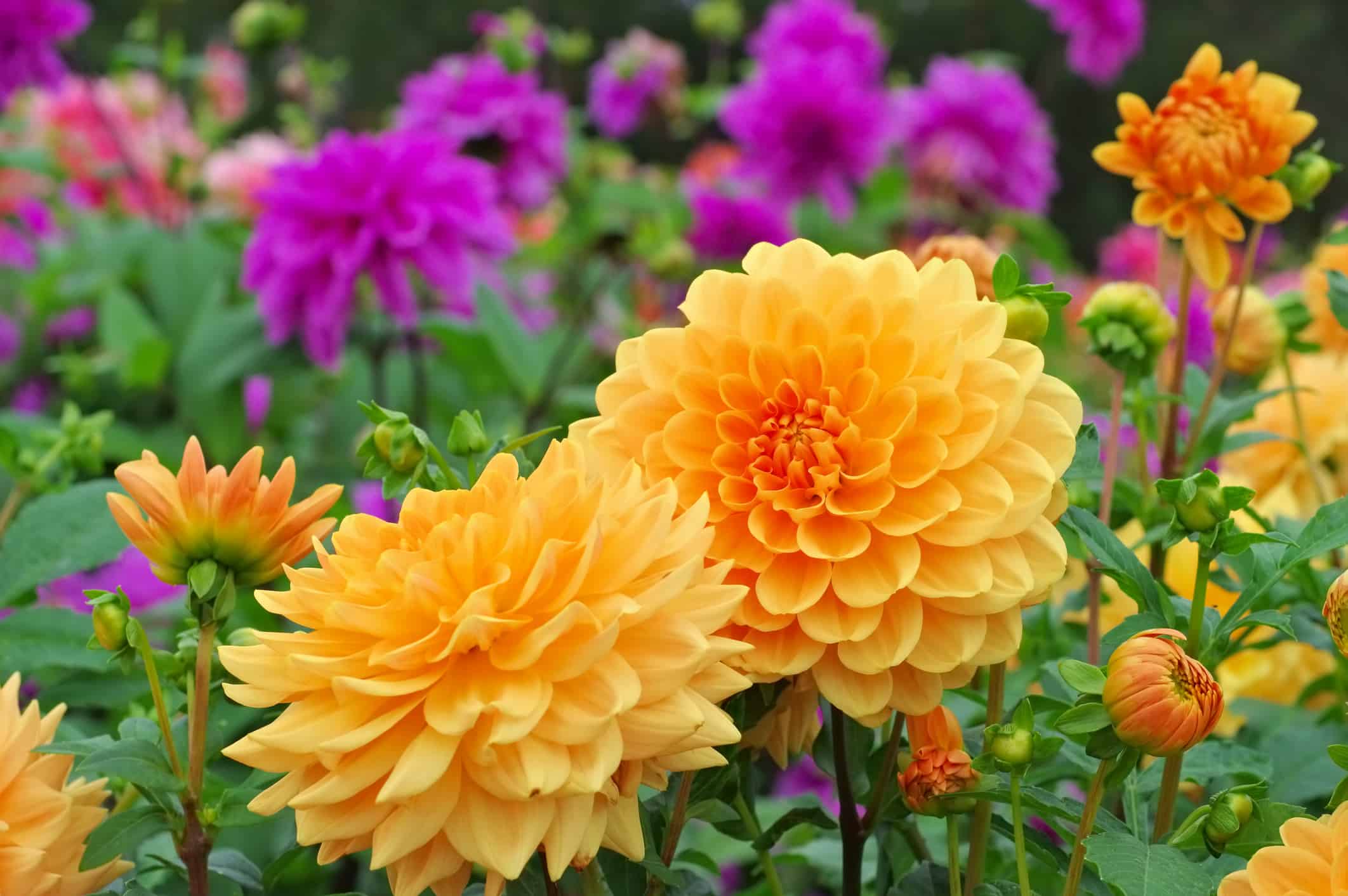If you have ever grown dahlias, you know how these vibrant, show-stopping flowers can transform your garden. However, their stunning beauty also makes them a target for hungry deer, who often graze on garden plants. Discover the answer to “Are dahlias deer-resistant?” along with effective strategies to keep these graceful herbivores away from your precious blooms.
Are Dahlias Deer-Resistant?
Homeowners and gardeners love dahlias for their vibrant and diverse blooms. However, one common concern among dahlia enthusiasts is whether these beautiful flowers are deer-resistant. Unfortunately, dahlias are not naturally deer-resistant, and deer have a taste for many garden plants, including dahlias. These lithe animals can be a significant threat to your dahlia blooms.
Nevertheless, there are several strategies and precautions you can take to help protect your dahlias from hungry deer and ensure your garden remains a colorful and thriving haven.

There are thirty species of dahlia.
©iStock.com/AndreaObzerova
9 Ways To Keep Deer Away From Your Dahlias
Discover nine methods to safeguard your dahlias from hungry deer.
1. Physical Barriers
One of the most straightforward ways to protect your dahlias from deer is by implementing physical barriers in your garden. These barriers act as a deterrent, preventing deer from accessing your beloved blooms. Some effective options to consider include:
- Fencing: Installing a sturdy fence around your dahlia garden is one of the most effective ways to keep deer out. Choose a fence that is at least 8 feet tall, as deer can jump surprisingly high. Additionally, solid wood or metal fencing works best.
- Netting and mesh: Protect individual plants or smaller areas with netting or mesh. This lightweight material drapes over your vulnerable landscape plants. It is also less obtrusive than a tall fence and an effective method for deterring deer.
- Deer-resistant plant cages: If you only have a few dahlia specimens, consider using individual cages or plant covers to deter deer. These can be an aesthetically pleasing solution that still allows you to showcase your dahlias.

Deer cannot jump a fence that is 7 feet tall or higher.
©Danita Delimont/Shutterstock.com
2. Deer Spray
These sprays are an effective way to deter deer, and there are also natural DIY techniques available. They work by emitting scents and tastes that are unpleasant to deer, making your garden less appealing to these graceful yet voracious visitors.
Commercial Spray
There are various commercial deer repellent sprays available at garden centers and online. These sprays usually contain natural ingredients like garlic, hot pepper, or rotten egg solids. Applying them to your dahlias forms a protective barrier of scent and taste that deer find repulsive.
- Liquid Fence is a popular brand known for its deer and rabbit repellent sprays. It uses natural ingredients to deter deer while being safe for your plants, pets, and the environment. Regular application can help keep deer away from your dahlias.
- Deer Off is another commercial option that combines both scent and taste deterrents. It can be effective in deterring deer from grazing on your blooms.
Homemade Deer Spray
If you prefer a DIY approach, you can create your own deer spray using readily available ingredients. These homemade deer repellent sprays work by targeting the deer’s sense of smell and taste, creating an environment that deer find unattractive for grazing. Regular application is key to maintaining their effectiveness and protecting your dahlias from deer damage.
Garlic and Cayenne Pepper Spray
How it works: The garlic and cayenne pepper spray combines two potent scents that deer find disagreeable. Garlic produces a strong odor that deer dislike, while cayenne pepper adds a spicy element that intensifies the repellent effect. When applied to your dahlias, this homemade spray creates a barrier of scent that makes the plants less appealing to deer. Additionally, the soap in the mixture helps the solution adhere to the leaves, ensuring its effectiveness over time.
Ingredients:
- 1 tablespoon of crushed garlic
- 1 tablespoon of cayenne pepper
- 1 tablespoon of dish soap
- 1 gallon of water
Instructions:
- Mix the crushed garlic, cayenne pepper, and dish soap into a gallon of water.
- Let the mixture sit for a day or two to allow the flavors to blend.
- Strain the mixture to remove any solids.
- Pour it into a spray bottle.
Application: Spray this homemade deer repellent directly onto your dahlia plants, coating the leaves thoroughly. Reapply after rainfall or as needed.
Soap and Water Solution
How it works: The soap and water solution deters deer primarily through its powerful scent. Deer have a keen sense of smell and are sensitive to unusual or unpleasant odors. The grated soap in the mixture emits a strong fragrance that deer find unappealing. As a result, they are less likely to approach and feed on your treated plants. The soapy residue also makes the leaves less palatable to deer.
Ingredients:
- 1 bar of strong-smelling soap (e.g., Irish Spring)
- 1 gallon of water
Instructions:
- Grate the bar of soap into small pieces.
- Mix the grated soap with a gallon of water and let it sit overnight.
- Stir the mixture until the soap dissolves completely.
- Transfer the solution to a spray bottle.
Application: Spray the soapy mixture directly onto your dahlias. The strong scent of the soap can deter deer from approaching your plants. Reapply after rainfall or as needed.
Vinegar Spray
How it works: This vinegar-based deer repellent spray works by creating an unpleasant scent and taste for deer. The strong odor of vinegar is often enough to deter deer from approaching your dahlias. However, the addition of dish soap helps the mixture adhere to the leaves, while the vegetable oil provides a sticking agent.
Ingredients:
- 1 cup of white vinegar
- 1 cup of water
- 1 tablespoon of vegetable oil
- 1 tablespoon of dish soap
Instructions:
- Combine the white vinegar, water, vegetable oil, and dish soap in a spray bottle.
- Shake the bottle thoroughly to mix the ingredients.
Application: On a dry day, spray the mixture onto your dahlia plants, coating the leaves, stems, and any areas where deer browse. Reapply the vinegar spray after rainfall or every few weeks to maintain its effectiveness as a deer deterrent.
Egg Spray
How it works: The egg spray creates a deterrent for deer through its odor and texture. As the mixture dries on the leaves of your dahlias, it produces an unpleasant scent that deer find unappealing. Additionally, the dried egg residue makes the foliage less palatable and more challenging for deer to graze upon. The combination of smell and texture makes this homemade egg spray an effective way to protect your dahlias from hungry deer.
Ingredients:
- 2 raw eggs
- 2 cups of water
Instructions:
- Blend the raw eggs and water until well mixed.
- Pour the mixture into a spray bottle.
Application: Spray the mixture evenly onto your dahlia plants, ensuring complete coverage of the leaves and stems. Allow the egg spray to dry on your plants. Reapply after rain or every few weeks to continue repelling deer from your dahlias.

Reapply deer spray after rainfall.
©Number One/Shutterstock.com
3. Deer-Resistant Companion Plants
Planting deer-resistant companion plants alongside your dahlias is a smart and natural way to shield your blooms from unwanted attention. These carefully chosen companions not only add aesthetic appeal to your garden but also serve as a living barrier that discourages deer from grazing.
Deer-resistant companion plants act as camouflage and also as protection for your dahlias. By inter-planting deer-resistant species with vulnerable plants, you create a less attractive environment for deer. These companion plants emit scents, tastes, or textures that deer find unappealing, making them less likely to approach and feed on your prized blooms. Additionally, some of these companions also serve as a visual distraction, diverting deer away from your dahlias and towards the more enticing alternatives.
Popular Deer-Resistant Varieties
- Lavender (Lavandula spp.): Gardeners everywhere prize lavender for its aromatic fragrance but also its deer-resistant qualities. Planting lavender near your dahlias not only deters deer but also attracts pollinators, enhancing the overall health of your garden.
- Salvia (Salvia spp.): Salvia, with its vibrant flowers and powerful scent, is another excellent choice for deer-resistant companion planting. It creates a protective barrier around your dahlias while adding a splash of color.
- Rosemary (Rosmarinus officinalis): Rosemary’s pungent aroma makes it unpalatable to deer. Placing rosemary near your dahlias can help safeguard them from browsing deer while providing you with a versatile herb for culinary use.
- Marigolds (Tagetes spp.): Marigolds not only repel deer but also offer a burst of cheerful color in your garden. Their strong scent and taste discourage deer from approaching your dahlias.
- Mint (Mentha spp.): Use mint’s aggressive growth habit to your advantage. Plant it as a ground cover around your dahlias to create a barrier that deer are less likely to cross.
- Foxglove (Digitalis purpurea): Foxgloves are not only deer-resistant but also add vertical interest to your garden. Their tall spires of tubular flowers hide your dahlias from curious animals. However, while foxglove is an effective deer-resistant companion plant, all parts of the plant are poisonous, making it unsuitable for gardens with pets or children.

Foxglove deters deer and attracts beneficial pollinators.
©iStock.com/Elmar Langle
4. Motion-Activated Deterrents
Incorporating motion-activated devices into your dahlia garden is a modern and highly effective method for deterring deer. These devices use motion sensors to detect deer and respond with various deterrents, creating an environment that discourages deer from grazing.
Motion-activated deterrents startle deer when they approach your garden. They use motion sensors, typically infrared or ultrasonic, to detect movement within a specific range. When a deer enters this range, the device activates, emitting a deterrent such as bright lights, loud noises, or bursts of water. The sudden and unexpected response startles deer, teaching them to associate your garden with discomfort and encouraging them to seek food elsewhere. Popular motion-activated deterrents include:
- Motion-activated sprinklers: These devices use a combination of motion sensors and water to deter deer. When a deer triggers the sensor, the sprinkler releases a sudden burst of water, startling the deer and causing them to flee.
- Solar-powered lights: Some motion-activated lights mimic the appearance of a predator’s eyes, which can deter deer. Solar-powered lights are energy efficient and easy to install, providing both a visual deterrent and nighttime garden illumination.
- Motion-activated alarms: These devices use motion sensors to trigger loud noises, such as sirens or recorded predator calls, scaring off deer that come too close.
Incorporating motion-activated devices into your dahlia garden provides an innovative and humane solution to deer-related challenges. These devices not only protect your beautiful blooms but also minimize the need for chemical or physical deterrents, promoting a safer and more environmentally friendly gardening experience.

Deer do not like the unexpected, including noise, movement, and water spray.
©Michal Sloviak/Shutterstock.com
5. Reflective Objects
Harnessing the power of reflective objects in your dahlia garden can be a simple yet effective way to deter deer. These objects create flashes of light and movement that unsettle deer, making your garden less inviting to them.
Often made from materials like aluminum or Mylar, placing reflective objects in your garden creates flashes of light when they catch the sun’s rays or wind movement. These unexpected glimmers mimic predators or unusual disturbances, triggering a natural deer instinct to avoid potential threats. As a result, deer are less likely to approach your dahlias.
Practical Reflective Objects
- CDs and DVDs: Hanging old CDs or DVDs from branches or stakes in your garden creates brilliant flashes of light and movement. These reflective discs are also cost-effective and readily available.
- Reflective tape: Tie Mylar or aluminum tape to stakes or branches throughout your garden. The slightest breeze causes the tape to flutter and reflect light, making it an excellent deterrent.
- Aluminum foil: Cut strips of aluminum foil and attach them to stakes or twine at various heights within your garden. When the sun hits them, or the wind blows, they create dazzling reflections that scare deer.
- Scarecrow balloons: Scarecrow balloons, often adorned with shiny, reflective surfaces, not only move with the wind but also mimic a potential predator. They are an eye-catching addition to your garden while serving as a deer deterrent.
- Reflective ornaments: Many decorative garden ornaments have reflective surfaces. These objects add a touch of style to your garden while helping to deter deer.
By incorporating reflective objects into your dahlia garden, you not only protect your blooms but also add an element of visual intrigue. These simple and humane solutions tap into the deer’s instinctual aversion to the unexpected and unfamiliar, creating a garden environment that is both beautiful and deer-resistant.

Deer have wide pupils, allowing them to see more light than humans.
©jessicahyde/Shutterstock.com
6. Strategic Planting
Strategic planting is a method that leverages the natural preferences and aversions of deer to create an environment that discourages their presence in your dahlia garden. By carefully selecting and positioning plants, you can enhance the protection of your dahlias while promoting a garden that is both beautiful and less appealing to deer.
One of the cornerstones of strategic planting for deer deterrence is the inclusion of deer-resistant plants as a protective shield for your dahlias. By surrounding your prized blooms with plants that deer avoid, you create a natural barrier that makes it less likely for deer to venture into your garden. Plants with strong scents, bitter tastes, or prickly textures are often unattractive to deer and can serve as an effective first line of defense.
Deer-Resistant Arrangements
Consider the layout and arrangement of your deer-resistant plants. Surround your dahlia garden with protective plants, creating a dense buffer that makes it difficult for deer to access your dahlias. Additionally, consider interspersing deer-resistant plants with your dahlias to create a visually appealing and functional garden design.
By adopting a strategic planting approach, you not only enhance the aesthetics of your garden but also minimize the attractiveness of your dahlias to deer. This harmonious balance between beauty and deterrence ensures that your prized blooms remain untouched, and your garden thrives as a welcoming space for both you and wildlife.

Plant thorny plants like globe thistle alongside vulnerable varieties to deter deer.
©Alex Manders/Shutterstock.com
7. Automatic Irrigation
An automatic irrigation system can serve as a clever and unexpected deer deterrence strategy. By setting your irrigation system to turn on at specific times, you can surprise and startle deer when they approach your garden, making it less attractive.
Deer, like many animals, are creatures of habit and become accustomed to patterns in their environment. By setting your automatic irrigation system to turn on at irregular intervals, you introduce an element of surprise that can deter deer from approaching your dahlias.
To maximize the effectiveness of this tactic, schedule your automatic irrigation system to operate when deer are most active, typically during dawn and dusk. Additionally, consider programming your irrigation system with variable watering patterns. Randomize the duration and intensity of watering cycles to keep deer guessing.
Motion-Activated Irrigation
For an even more effective approach, invest in a motion-activated irrigation system. These systems use motion sensors to detect deer or other wildlife and respond by turning on the water. When a deer triggers the sensor, it receives an unexpected spray of water, which can be highly effective in deterring deer from your garden.
By harnessing the element of surprise with automatic irrigation, you can create a garden environment that is less appealing to deer, encouraging them to seek sustenance elsewhere. This humane and creative approach not only protects your dahlias but also adds an unexpected layer of deer deterrence to your garden management strategy.

A sudden movement from sprinkler systems startles deer.
©iStock.com/
8. Ultrasonic Devices
Ultrasonic devices are another high-tech and innovative method for keeping deer at bay. These devices emit high-frequency sound waves that are unpleasant for deer but typically imperceptible to humans. When a deer approaches the device and triggers it, the sudden emission of these discomforting sound waves startles and deters them, encouraging them to retreat from the area.
Tips for Using Ultrasonic Devices Effectively
- Strategic placement: Position the ultrasonic device in a central location within your garden or near the area you want to protect. Ensure that it has a clear line of sight to areas frequented by deer.
- Range: Be aware of the coverage range of the device you choose. Different models have varying effective distances, so select one that suits the size of your garden and the proximity of deer to your property.
- Motion sensing: Many ultrasonic devices have motion sensors that detect movement and activate sound waves.
- Regular maintenance: Check and maintain your ultrasonic device to ensure it continues to function correctly. Check the batteries or power source, clean any debris that may accumulate on the device, and replace it if it becomes damaged or less effective.
- Experiment: Some ultrasonic devices offer adjustable frequency settings. Experiment with different frequencies to find the one that is most effective in deterring deer in your specific area.
- Use a combination approach: Ultrasonic devices work well in combination with other deer deterrent methods, such as visual scare tactics or reflective objects, to create a more comprehensive defense strategy for your dahlias.
By incorporating ultrasonic devices into your deer deterrence plan, you can benefit from a high-tech solution that discourages deer without causing harm. These devices offer a humane and non-chemical approach to protecting your dahlias and maintaining a thriving garden.

Ultrasonic devices are inaudible to humans and do not violate noise ordinances.
©Kristine Rad/Shutterstock.com
9. Routine Lawn Maintenance
Routine lawn maintenance is not just about keeping your grass green and tidy; it plays a significant role in creating a deer-resistant environment for your dahlias. A well-maintained lawn can deter deer by reducing their access to shelter, making it less attractive for them to browse. Discover key reasons lawn maintenance matters for deer deterrence:
- Open sightlines: Regularly mowing your lawn and trimming overgrown vegetation ensures open sightlines in your garden. Deer prefer areas with cover and are less likely to venture into open, well-maintained spaces where they feel vulnerable.
- Reduced shelter: Frequent lawn maintenance eliminates potential hiding spots for deer. Tall grass, dense shrubbery, and untamed vegetation can serve as a refuge. By keeping your lawn neatly trimmed, you remove these hiding places, making it less appealing for deer to roam.
- Enhanced visibility: A well-maintained lawn provides better visibility, allowing you to detect deer more easily. This heightened awareness enables you to take prompt action, such as activating deer deterrent devices, before deer reach your dahlias.
Practical Tips for Routine Lawn Maintenance
Routine lawn maintenance serves as a foundational element of your deer deterrence strategy. By keeping your lawn neat, open, and uninviting to deer, you create a garden environment that is less attractive to browsing deer, helping to safeguard your dahlias and other cherished plants.
- Mow regularly: Keep your lawn mowed at a consistent height. Frequent mowing prevents grass from becoming too tall and keeps your garden open and uninviting to deer.
- Trim vegetation: Trim and prune shrubs, bushes, and trees around your garden to eliminate potential cover and hiding spots for deer. Additionally, maintain a clear buffer zone around your dahlias.
- Weed control: Keep weeds in check to prevent them from attracting deer. Weedy areas can provide an additional food source for deer, making them more likely to visit your garden.
- Maintain barriers: If you have deer fencing in place, ensure it is well-maintained and free from damage. Regularly inspect and repair weak areas.
- Monitor your landscape: Watch For signs of deer activity, such as tracks or droppings, and respond promptly by reinforcing your deer deterrence measures.

Eliminate easy browsing and hiding places by pruning vegetation.
©iStock.com/Yarygin
A Comprehensive Approach
Safeguarding vulnerable landscape plants requires a multifaceted approach. While deer add to the allure of your garden, their browsing habits pose a significant challenge. By combining several deer deterrent methods, you can maintain the beauty of your dahlias while preserving a harmonious coexistence with wildlife.
Thank you for reading! Have some feedback for us? Contact the AZ Animals editorial team.








